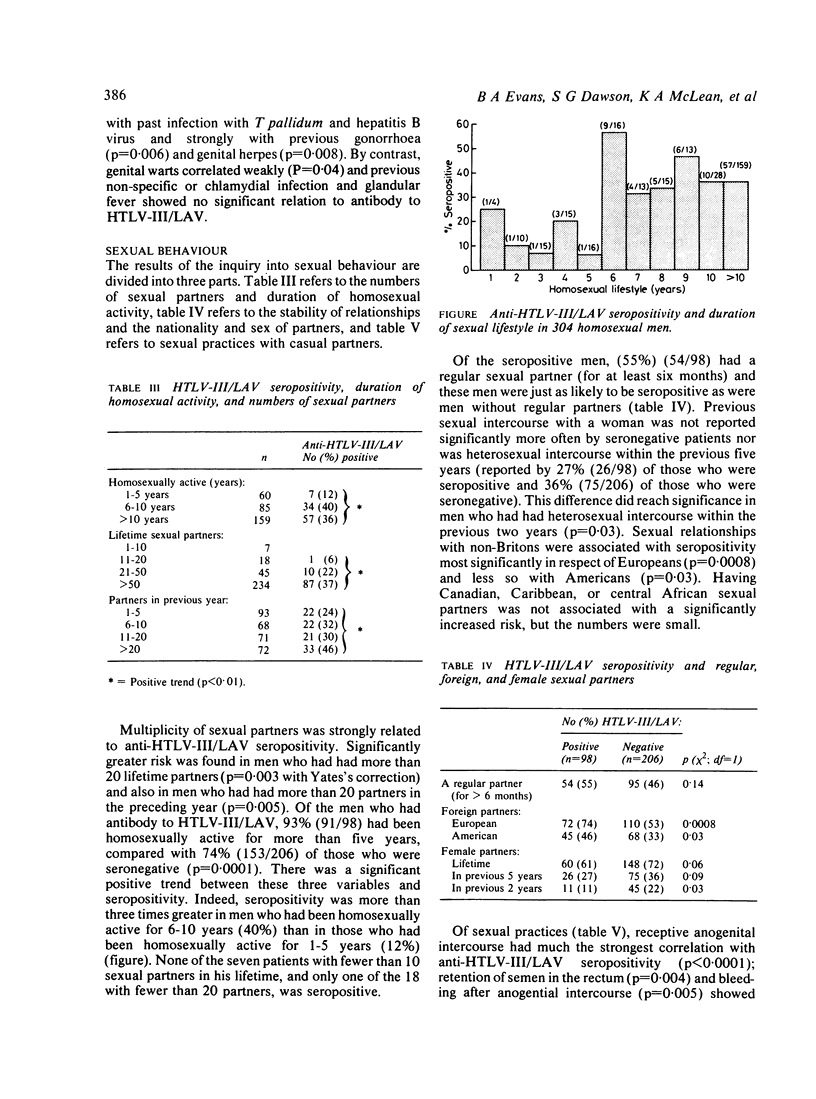Abstract
A study of 304 sexually active homosexual men, most of whom had multiple casual partners, showed that receptive anogenital intercourse, independent of anal bleeding, was the only risk factor for HTLV-III/LAV transmission. There was no evidence that HTLV-III/LAV infection, measured by seropositivity, was transmitted by oroanal or orogenital routes, or that insertive penile intercourse constituted a risk. The strongest predictor of seropositivity proved to be homosexual activity for more than five years, which may lead to enhanced susceptibility to infection. Sexual exposure to European men seemed to be even more hazardous than sexual exposure to men from the United States of America, and emphasised the epidemiological importance of the promiscuous homosexual abroad. Skin complaints were the most common presenting symptoms in men with antibody to HTLV-III/LAV. Extrainguinal lymphadenopathy was the commonest sign, which was present in just under half of those who were seropositive. More than one quarter of seropositive patients had had sexual intercourse with a woman in the five years before being tested.
Full text
PDF





Selected References
These references are in PubMed. This may not be the complete list of references from this article.
- Goedert J. J., Sarngadharan M. G., Biggar R. J., Weiss S. H., Winn D. M., Grossman R. J., Greene M. H., Bodner A. J., Mann D. L., Strong D. M. Determinants of retrovirus (HTLV-III) antibody and immunodeficiency conditions in homosexual men. Lancet. 1984 Sep 29;2(8405):711–716. doi: 10.1016/s0140-6736(84)92624-2. [DOI] [PubMed] [Google Scholar]
- Ho D. D., Schooley R. T., Rota T. R., Kaplan J. C., Flynn T., Salahuddin S. Z., Gonda M. A., Hirsch M. S. HTLV-III in the semen and blood of a healthy homosexual man. Science. 1984 Oct 26;226(4673):451–453. doi: 10.1126/science.6208608. [DOI] [PubMed] [Google Scholar]
- Jaffe H. W., Choi K., Thomas P. A., Haverkos H. W., Auerbach D. M., Guinan M. E., Rogers M. F., Spira T. J., Darrow W. W., Kramer M. A. National case-control study of Kaposi's sarcoma and Pneumocystis carinii pneumonia in homosexual men: Part 1. Epidemiologic results. Ann Intern Med. 1983 Aug;99(2):145–151. doi: 10.7326/0003-4819-99-2-145. [DOI] [PubMed] [Google Scholar]
- Marmor M., Friedman-Kien A. E., Zolla-Pazner S., Stahl R. E., Rubinstein P., Laubenstein L., William D. C., Klein R. J., Spigland I. Kaposi's sarcoma in homosexual men. A seroepidemiologic case-control study. Ann Intern Med. 1984 Jun;100(6):809–815. doi: 10.7326/0003-4819-100-6-809. [DOI] [PubMed] [Google Scholar]
- Mavligit G. M., Talpaz M., Hsia F. T., Wong W., Lichtiger B., Mansell P. W., Mumford D. M. Chronic immune stimulation by sperm alloantigens. Support for the hypothesis that spermatozoa induce immune dysregulation in homosexual males. JAMA. 1984 Jan 13;251(2):237–241. doi: 10.1001/jama.251.2.237. [DOI] [PubMed] [Google Scholar]
- Melbye M., Biggar R. J., Ebbesen P., Sarngadharan M. G., Weiss S. H., Gallo R. C., Blattner W. A. Seroepidemiology of HTLV-III antibody in Danish homosexual men: prevalence, transmission, and disease outcome. Br Med J (Clin Res Ed) 1984 Sep 8;289(6445):573–575. doi: 10.1136/bmj.289.6445.573. [DOI] [PMC free article] [PubMed] [Google Scholar]
- Mortimer P. P., Jesson W. J., Vandervelde E. M., Pereira M. S. Prevalence of antibody to human T lymphotropic virus type III by risk group and area, United Kingdom 1978-84. Br Med J (Clin Res Ed) 1985 Apr 20;290(6476):1176–1178. doi: 10.1136/bmj.290.6476.1176. [DOI] [PMC free article] [PubMed] [Google Scholar]
- Muhlemann M. F., Anderson M. G., Paradinas F. J., Key P. R., Dawson S. G., Evans B. A., Murray-Lyon I. M., Cream J. J. Early warning skin signs in AIDS and persistent generalized lymphadenopathy. Br J Dermatol. 1986 Apr;114(4):419–424. doi: 10.1111/j.1365-2133.1986.tb02845.x. [DOI] [PubMed] [Google Scholar]
- Nicholson J. K., McDougal J. S., Jaffe H. W., Spira T. J., Kennedy M. S., Jones B. M., Darrow W. W., Morgan M., Hubbard M. Exposure to human T-lymphotropic virus type III/lymphadenopathy-associated virus and immunologic abnormalities in asymptomatic homosexual men. Ann Intern Med. 1985 Jul;103(1):37–42. doi: 10.7326/0003-4819-103-1-37. [DOI] [PubMed] [Google Scholar]


